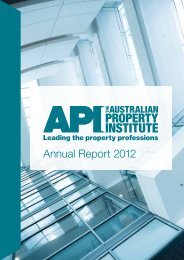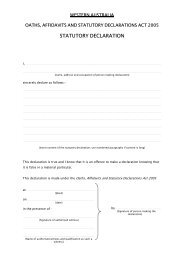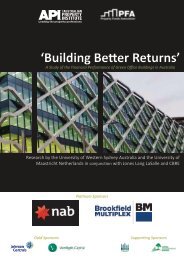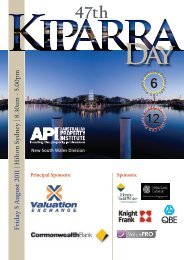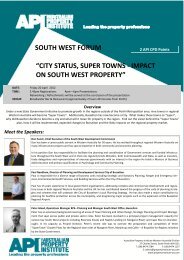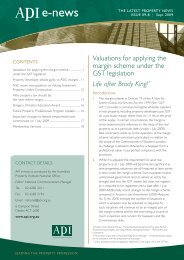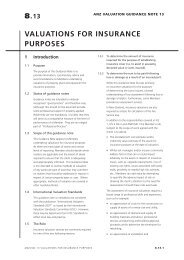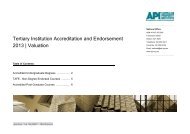CARBON TAXherds away from methane-producinganimals to non-ruminant indigenoussources such as kangaroo; reducingthe size of farm operations whilstmaintaining the farm size, such aslowering stock rates and less intensivecropping; and creating a form of‘carbon sink’ by either re-forestation oranother source of bio-fixing of carbonsuch as in-soil sequestration.A sectoral analysis using agriculturalcommodity models suggests thatsectoral output would fall by from halfa percentage point to over 4% when thepermit price is $25 per CO2 equivalent.This estimate of downturn would meanthat a carbon price of $25 per tonnecarbon dioxide has the potential to closeup to 14% of beef producers, being thesmaller farms in the sector (Jiang, 2009).<strong>The</strong> most progressed thinkingto try to offset some of the carbonissues is the re-forestation of degradedland – land close to waterways orstrategic land which will form shade orwindbreaks for more efficient overallfarm production. However, currentlythe harvesting of trees or their lossin a natural disaster such as bushfirewould be treated as an emission underthe Kyoto Protocol. As a result of thisthe owner of the forest would have tosurrender the credits unless the treesare replanted immediately after anevent as the CPRS has a requirementfor tree plantations to be maintainedfor 100 years.Carbon Neutral reports on its website:“We currently plant an averageof six to seven trees per tonne. In the350-450 mm rainfall area of WA,we estimate the number of treesrequired per tonne of CO2 varies fromfour to 10 depending on location,species of tree, soil type and type ofplanting. If we could plant karri treesin 1,000 mm rainfall areas, it could bemore than a tonne of CO2 per tree!”(Wilson, 2010)<strong>The</strong> <strong>Australian</strong> GreenhouseOffice (AGO) has also developed awebsite where information can be putin to calculate how much carbon issequestered by a hectare of forest. <strong>The</strong>approximate average allowed within an<strong>Australian</strong> context is around 600 to 650tonnes of carbon per hectare during a25- to 30-year growing cycle for most<strong>Australian</strong> hardwood species.<strong>The</strong> AGO has calculated a 30 tonneper annum figure for the scenariodeveloped by Private Forestry SouthernQueensland, which was a trial plot oftimber near Kenilworth. <strong>The</strong> initial datawas entered prior to planting and is beingupdated as the trees grow. However,20 tonne was used in calculations as aconservative benchmark.IT IS THE EXTENT TO WHICH RURALINDUSTRIES AND HIGH EMITTING INDUSTRIESARE CAPTURED WITHIN ANY CPRS WHICH WILLINEVITABLY CREATE THE PRICE FOR CARBONAND THE AMOUNT THAT PEOPLE ARE WILLINGTO PAY TO AVOID THE COSTSoil carbon sequestration is alsopotentially a very large pool, with aglobal estimate of 2.3 trillion tonnesof available matter, three times that ofcarbon in the atmosphere. This pool ofcarbon storage or sequestration is thatcontained in soil microbes, worms etc;labile carbon of decaying plant matter;and fixed carbon in stable compounds.This is separate to the sequestrationin forestry timber and subterraneanburial, which was proposed for somepower stations with the capture at thetop of the stack and then pumping downto great depths in the earth stratum.However, a big hurdle to adoptingthese practices is how to measure andAre you managing, selling, leasing or subleasing commercial ofce space?<strong>The</strong> Commercial Building Disclosure Program mandates the disclosure of energy ef ciency in large commercial of ce spaces.<strong>The</strong> Building Energy Ef ciency Disclosure Act 2010 requires that before sale, lease or sublease, most commercial of ce buildings with a net lettable area of 2000m² or more, need todisclose an up-to-date energy ef ciency rating in a Building Energy Ef ciency Certi cate (BEEC).BEECs are valid for up to 12 months, must be publicly accessible on the online Building Energy Ef ciency Register, and include:• a NABERS Energy star rating for the building• an assessment of tenancy lighting in the area of the building that is being sold or leased and• general energy ef ciency guidance.<strong>The</strong> NABERS Energy star rating must also be included in any advertisement for the sale, lease or sublease of the of ce space.<strong>The</strong> Commercial Building Disclosure Program creates a well informed property market and stimulates demand and investment in energy ef cient buildings.For more information about the Commercial Building Disclosure Program visit www.cbd.gov.au or email info@cbd.gov.au.AG65703
CARBON TAXINDUSTRYRETURN ON INVESTMENT(inc. capital growth allowances)RETURN ON INVESTMENT(ex. capital growth allowances)Beef cattle -1.3% to 2.5% -1.5% to 1.7%Dairy production -3.2% to 6.2% -3.9% to 4.1%Grain production 2.1% to 3.5% 1.0% to 1.9%Lamb/sheep production 3.7% to 4.2% 0.2% to 2.1%Private farm forestry calculation(excluding carbon income)3.46% to 4.56% 1.5% to 2.1%Private farm forestry calculation(including carbon income)4.31% to 5.64% 2.2% to 3.5%Source: ABARE 2009 & auther 2011verify the carbon sequestered/abatedin a quick, reliable and cost-effectiveway. Directly measuring every farm’ssequestration is most accurate butnot financially feasible. An indirectpractice-based model, combined withsoil sampling, carbon modelling andrandom verification, however, seemslike a viable option (Jiang, 2009).THE RETURN ON PRIVATE FARMFOREST INTEGRATED INTO A FARM<strong>The</strong> scenario is based upon the SouthEast Queensland sub-tropical wetsclerophyll zone. <strong>The</strong> amount of carbonwhich will potentially be sequestered isassessed via the AGO modelling toolwebsite, with the study based upon amixed Eucalyptus cloeziana (GympieMessmate), Eucalyptus punctata (GreyGum) and Corymbia maculata (SpottedGum) native hardwood forest.Data was entered into the tool box,along with rainfall, soil informationand management regime by Sean Ryanof Private Forestry Service Queensland.<strong>The</strong> prediction accounts for the totalcarbon sequestered within the trees,soil and debris. It is expected that thecurrent 100% discount for harvestedmaterial will change in the foreseeablefuture and will allow for carbon storedas either a sawn product or power pole,etc (Ryan, 2010).Based upon average growth ratesand a carbon price of $23 per tonne,the farm income shows a return oninvestment (ROI) of 4.56% for theforest. This return includes a landfigure at the current price for accuracyin return analysis. It should be notedthat only half of carbon credit needs aresourced from Australia. New Zealandhas seen many credits purchased offshore in Mali and similar locations. Alower price for credits would decreasethe return by around 1%.THE MOST PROGRESSED THINKING TO TRY ANDOFFSET SOME OF THE CARBON ISSUES IS THERE-FORESTATION OF DEGRADED LAND.<strong>The</strong> data was also run for a variationin the analysis accounting for slowergrowth rates, with a slower growthrate changing the original return tothe farm from 4.56% down to 3.46%and pricing for quality also impactingon results.<strong>The</strong> 2007 to 2009 ABARE data(ABARE, 2011) has been summarisedfrom its <strong>Australian</strong> farm surveys 2010industry series in figure 1 (page 512).<strong>The</strong> table above comprisesa comparison of rural industryfarm returns (ABARE 2009 andauthor 2011).Whilst there has been a push topursue the ‘carbon neutral farm’, it isworth noting that Andrew Duffy, asheep grazier and winner of the 2009Raising the Baa competition and whohas planted forest on around 17% ofhis property with Melville Forest, wasquoted in an article as saying, “Basedon present production estimates,Melville Forest emits some 2,250tonne of CO2 equivalents per year.To offset this [it] would take 580 haof plantations or 40% of the property(Cuming, 2009).CONCLUSIONWhile legislation was passed inFederal parliament in late 2011 fora carbon price of $23 per tonne,the full ETS or other trading schemeis yet to be enacted. <strong>The</strong> mostknowledge we have is of re-forestation,so it will be the primary way forcredits to be purchased; for example,the option of offsetting a Qantasflight with the company purchasingtrees for planting. An economicand accurate measurement ofcarbon sequestration projectionsof stable carbon humates deeperthan 100mm is yet to be completedand internationally recognised socurrently re-forestation will progressas the primary option for offsettingcarbon emissions.514 <strong>ANZPJ</strong> SEPTEMBER <strong>2012</strong>



